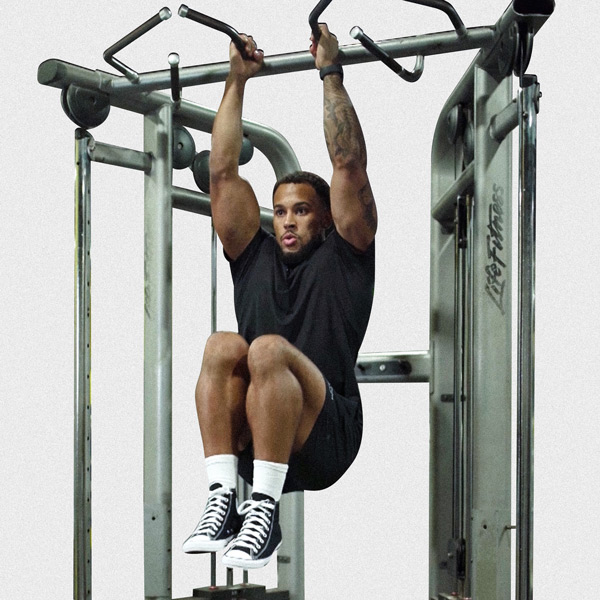Captain's Chair Knee Raise
Bodyweight core exercise on Captain's Chair that targets lower abs and hip flexors to build core stability and endurance; commonly used for abdominal strength and hypertrophy.
About Exercise
Equipment
Captain's Chair
Difficulty
3/5 • Beginner
Primary Muscle Groups
Abs, Hip Flexors
Secondary Muscles
Forearms
Accessory Muscles
Lower Back
Popularity Score
7
Goals
Training Style
Setup Requirements
Requires Rack
No
Requires Bench
No
Requires Spotter
No
Space Needed
Small
Noise Level
Low
Muscle Breakdown
View Muscle MapAbs
10/10Rectus Abdominis, Transverse Abdominis
Hip Flexors
9/10Iliopsoas
Obliques
6/10External Obliques, Internal Obliques
Forearms
3/10Flexors
Lower Back
2/10Erector Spinae
Programming
Typical Rep Range
8-20 reps
Rest Between Sets
30-60 seconds
How to Perform
Step into the Captain's Chair, place forearms on padded supports, grip handles, and let legs hang straight down with back against the pad.
- Brace core and tuck pelvis slightly.
- Exhale and engage abs to raise bent knees toward chest.
- Lift until thighs are parallel to floor.
- Squeeze abs at top and hold briefly.
- Inhale and lower legs slowly to start.
- Keep movement controlled without swinging.
Coaching Tips
Form Cues
- Keep shoulders depressed
- Tuck pelvis to engage lower abs
- Control descent slowly
- Avoid swinging legs
- Maintain neutral spine
Breathing
Inhale as you lower your legs; exhale forcefully as you raise them while bracing your core.
Tempo
2-1-2
Range of Motion
Start with legs fully extended hanging down; raise knees until thighs reach parallel to floor or hips tuck, then lower without full lockout at bottom.
Safety
Safety Notes
- Avoid if acute lower back pain or shoulder instability
- Prioritize form over range if limited mobility
- Maintain core tension to prevent arching
- Control descent to avoid strain
- Skip if pregnant or post-surgery
- Consult physician for diastasis recti
Spotting
Spotting not required; use machine's stability. For beginners, have a partner support legs if needed to prevent swinging.
Common Mistakes
- Swinging legs with momentum
- Arching lower back
- Shrugging shoulders
- Dropping legs too quickly
- Not engaging core fully
When to Avoid
- Acute lower back pain
- Shoulder instability
- Pregnancy
- Post-childbirth recovery
- Abdominal surgery recovery
- Diastasis recti
Flexibility Needed
- Shoulder flexion for support
- Ankle dorsiflexion minimal
- Hip flexion range
- Core control for stability
Build Up First
- Basic core engagement competency
- Familiarity with hanging positions
- Ability to maintain neutral spine
Also known as
Vertical Knee Raise, Hanging Knee Raise, VKR Knee Raise
Found this helpful?
Share your thoughts or help us improve this guide.
Similar Exercises

Captain's Chair Leg Raise
Captain's Chair
Abs

Hanging Knee Raise
Pull-up Bar
Abs

Weighted Hanging Knee Raise
Pull-up Bar, Dumbbells
Abs

Chair Pose
Bodyweight
Quads

TRX Knee Tuck
TRX
Abs

Kettlebell Kneeling Around the World
Kettlebell
Abs

TRX Leg Raise
Others
Abs

Lying Leg Raise
Bodyweight
Abs
Balance Trainer Knee Tuck
Balance Trainer
Abs

High Knees

Bodyweight
Quads


subscribe to our newsletter
Contact Us
hello@trainfitness.aiFind Us
130 Spadina Avenue, Toronto,
Ontario, M5V 0H4, Canada
©2025 All Rights Reserved
